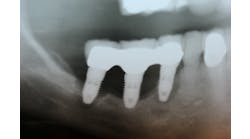Belgian researchers report high dental implant survival rate 16 years after placement
More than 16 years after implant placement, the cumulative survival rate of a group of single-implant patients treated at the Dental Specialist Clinic in Malmö, Sweden, between 1987 and 1993, was 91.5%, a Belgian research team reported at the 27th Annual meeting of the Academy of Osseointegration (AO).
“After more than 16 years of function, all surviving implants were still supporting a functional single crown,” reported Dr. Melissa Dierens, Department of Periodontology and Oral Implantology, University Hospital of Ghent, Gent, Belgium.
Although titanium dental implants have been used for single-tooth replacement since the late 1980s, few long-term studies have been available about their success. The mean follow-up of the patient group Dr. Dierens clinically investigated was 18.4 years. Dental implants had failed in only 2 of 50 patients who received 62 implants.
“In 75% of cases, the original crown was still in place. The main reason to renew a crown was esthetically-driven rather than because of technical failure,” Dr. Dierens told her audience during AO’s Annual Meeting in the Phoenix Convention Center, March 1-3.
Complete program information is available through the Academy’s website.
With more than 6,000 members in 70 countries around the world, the Academy of Osseointegration is the world’s leading dental implant organization. Its goal is to advance the field of osseointegrated implants by fostering collaboration between representatives of different dental disciplines — oral surgery, periodontics, prosthodontics, and general practice — through clinical and evidence-based research and education.
Founded in 1985, it provides a focus for the rapidly advancing biotechnology involving the natural bond between bone and certain alloplastic reconstructive materials. In dentistry, the primary application is replacing missing teeth by affixing a titanium implant into the jawbone, then securing an artificial tooth into the implant that will look, feel, and function like a natural tooth.






